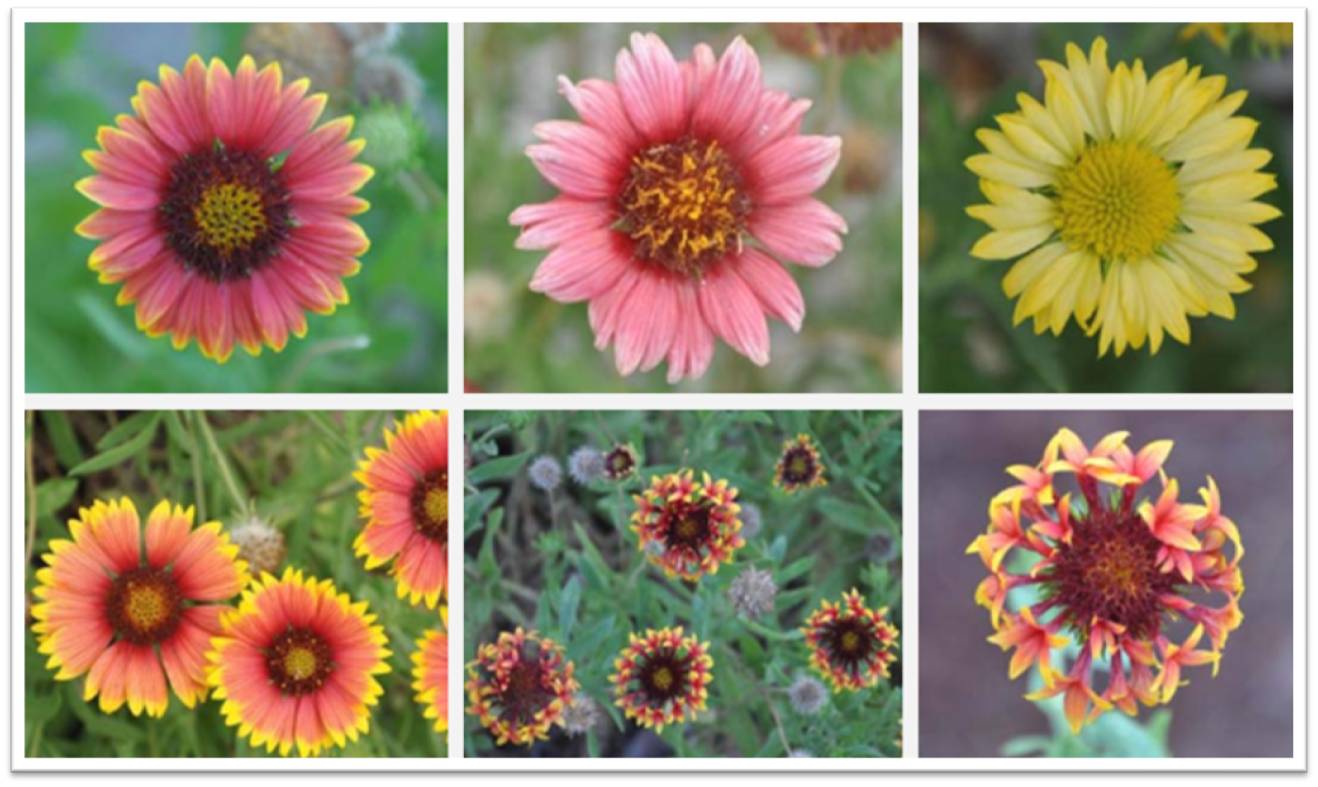
by Alex Bolques | Jul 22, 2013
Gaillardia is a favorite one of many wildflowers throughout the United States. It is a member of the Aster family, and is most commonly known as Indian Blanket or Blanket Flower. Individual plants can reach up to 2 feet high. They are heat and drought tolerant and, in Northwest Florida, flower from summer through fall.
The entrance to the Gadsden County Extension Office is flanked on either side by stands of Indian Blankets. Blooms are an array of red, orange, and yellow. While it may be rare to find a flower with the center cone and petals completely yellow or orange, they are evident in our garden. What most people find peculiar is appearance of tubular, trumpet-like, florets on the flower ray.
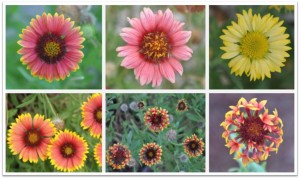
Gaillardia pulchella
The striking display of flower color Indian Blanket offers is not its only feature. It is also a source of nectar for many different butterfly species. Stephen Brown, a horticulture agent in Lee County Florida, has an excellent publication on Gaillardia pulchella that lists this plant species’ interesting attributes.
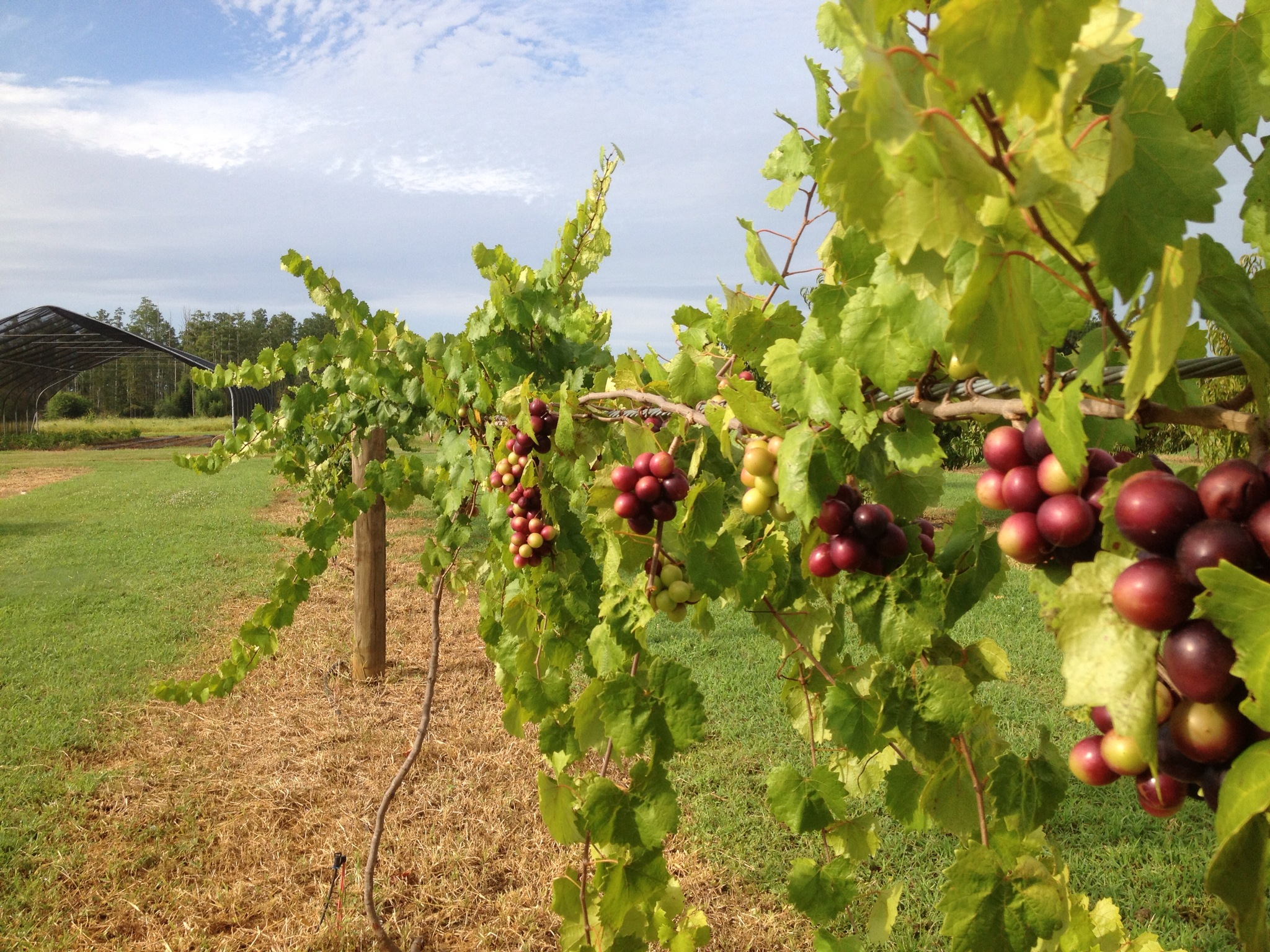
by Blake Thaxton | Jul 22, 2013
Fruit trees are a wonderful addition to the landscape at home or even a great niche for the small farmer.

Most people love the thought of picking fresh fruit off of the tree or vine and knowing exactly where it comes from. There are a lot of considerations that must be taken into account for a homeowner looking to spice up the landscape or the small farmer looking to diversify their operation.
 Chill Requirements:
Chill Requirements:
Deciduous trees have a chilling requirement in order to flower and produce fruit. Species and cultivars will have their own number of chill hours that must be met. Chill units are the estimated accumulative number of hours at 45°F or under during the dormant season. The Panhandle of Florida receives the most chill units in the state, therefore allowing more of a selection of fruit trees.
Disease Pressures:
Pecan, Peach/Nectarine, Plum, Bunch Grape, Apple, and Pear all have high disease pressures in the climate of the Florida Panhandle. Peach and Nectarine, for example, have a high number of necessary fungicide sprays required for high quality fruit. Mushroom root rot, peach scab, bacterial leaf spot, and brown rot are a few diseases of Peach and Nectarine. The other fruits mentioned have a similar list of disease problems that demand frequent and timely applications of fungicides.
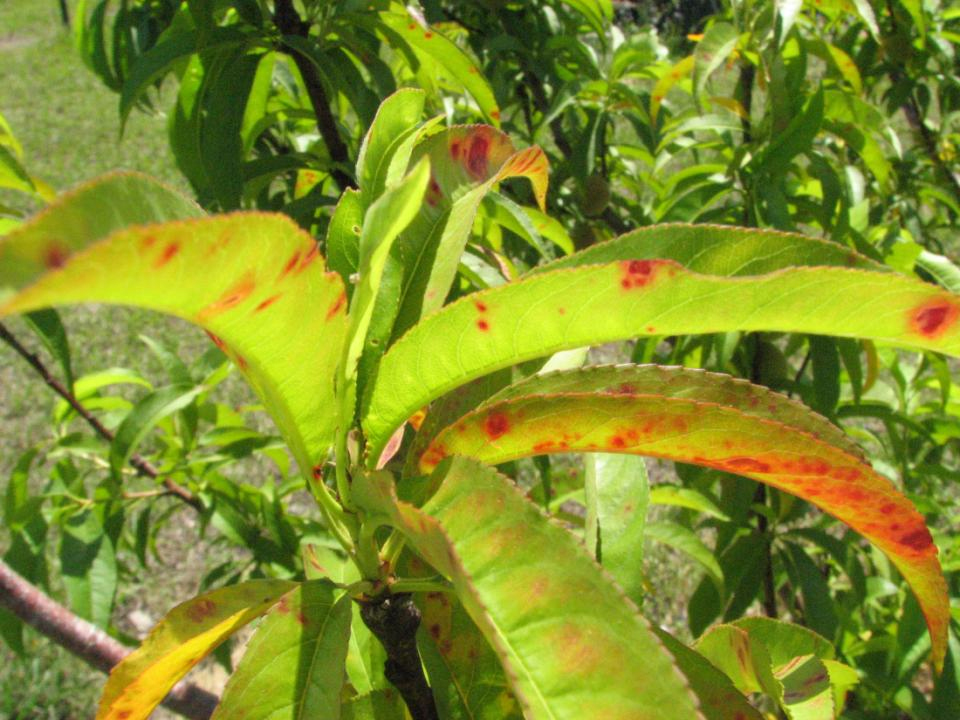
Peach tree affected by Bacterial Leaf Spot symptoms. Photo by G. England.
Along with disease pressures and chilling requirements, there are other factors that have to be taken into account before installing fruit trees in Northwest Florida. The sustainability of fruit trees in North Florida can be read about further in this UF/IFAS publication. In the publication, proper varieties and cultivars are listed for the fruit crops discussed. To learn more about fruit culture in Florida, please take a look at the following linked publications.
If questions arise about whether a certain fruit crop can be grown in the Florida Panhandle, contact your local extension agent.
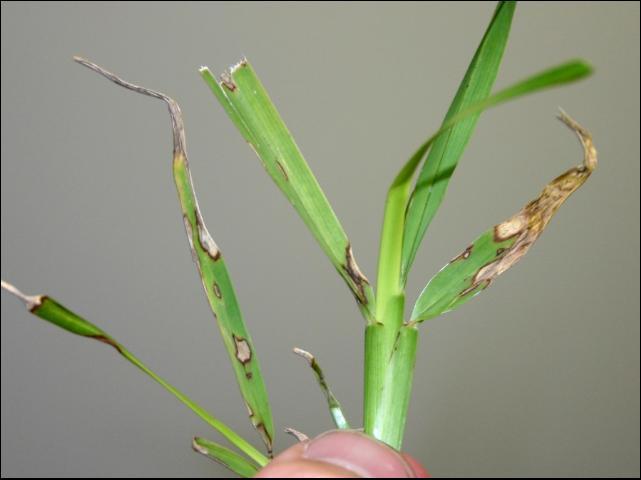
by Larry Williams | Jul 22, 2013
Gray Leaf Spot is a common fungal disease of St. Augustinegrass. Recent wet conditions have promoted this disease. This includes high humidity, heavy dews and particularly frequent afternoon and evening rains.
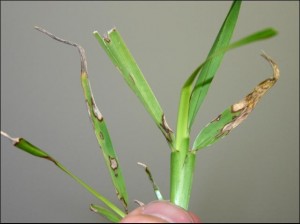
Gray leaf spot symptoms on St. Augustinegrass. Photo credit: UF/IFAS Extension
The individual spots or lesions are first seen as tiny brownish spots smaller than a pinhead. As they become larger, they will be circular and then begin to elongate lengthwise along the leaf. The spots will become brown to grayish in appearance. Numerous spots or lesions may be found on an individual leaf. Heavily infected leaves begin to turn brown and wither, usually beginning at the tip of the blade.
Gray leaf spot can move rapidly during prolonged warm, wet periods. Over watering or irrigating in the evening provides the prolonged period of wetness required for disease infection. For more information on how to correctly water a Florida lawn, visit the UF / IFAS Lawn Watering Website.
According to the Florida Lawn Handbook, “Severity of the disease is enhanced by application of readily available nitrogen fertilizer and is proportional to the amount of nitrogen applied.” Select fertilizers that are low in nitrogen or that have slow release nitrogen. Be careful to not overdo it in fertilizing your lawn and do not apply a high nitrogen fertilizer on top of an already infected lawn. Also, some lawn weed killers such as atrazine will increase the susceptibility of the grass to gray leaf spot.
Irrigate during early morning hours to minimize the period in which the grass is wet and water only on an as needed basis, watering less often but deeply. Avoid frequent, shallow watering and don’t irrigate when the lawn is already wet from rain. With the recent frequent rains, very little to no supplemental irrigation has been needed on most lawns in our area. Avoid leaving irrigation timers on when adequate rainfall has occurred. It’s best to operate irrigation controllers on manual so that the lawn can be monitored and irrigation provided during dry times.
If the disease outbreak is severe, fungicide may be needed. Look for products containing propiconazole, triadimefon or thiophanate-methyl. Always follow the product’s label directions and precautions.
For more information on maintaining a Florida lawn, contact your County UF/IFAS Extension Office or visit the YourFloridaLawn Website.
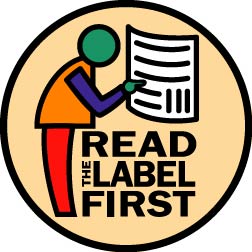
by Julie McConnell | Jul 22, 2013
 When you contact your local extension office for pest control recommendations you will likely hear “follow the label” over and over again. So, why do we emphasize the pesticide label so strongly when talking to both homeowners and landscape professionals?
When you contact your local extension office for pest control recommendations you will likely hear “follow the label” over and over again. So, why do we emphasize the pesticide label so strongly when talking to both homeowners and landscape professionals?
There are many important reasons why you should always read and follow label instructions.
- The Label is the Law – using a pesticide in a manner that is inconsistent with the label is a violation of the Federal Insecticide, Fungicide, and Rodenticide Act (FIFRA). Using a product inconsistent with the label includes, but is not limited to: rate of application, use on site not labeled for control, use on plants/lawns not labeled, frequency of application, method of application, distance from water sources, etc.
- Safety of Humans – using a product incorrectly can cause harm or even lead to death
- Safety to Non-target Organisms – this includes non-target insects, reptiles, birds, fish, mammals, and plants which can lead to negative impact on environment and economy
- Effectiveness of Product – millions of dollars are spent to figure out the most effective way a product works best, follow their instructions! (remember the manufacturer wants the product to be effective so that you’ll recommend to others and buy it again)
- Increased Resistance Decreases Control – improper application and a failure to rotate products as part of an integrated pest management program can increase likelihood of resistant pest populations
Before shopping for any pesticides, do some research:
- Has the pest been identified properly? What life cycle stage is the pest at? Most pesticides have different levels of efficacy depending on life cycle of target. For example, glyphosate works best on young plants that have not yet flowered. Your local extension office can help with identification and timing of control methods
- Can you control the pest with cultural practices such dethatching, irrigation, fertilizer, or mowing height changes? Start with the least toxic method of control and only work up if ineffective
- Read the label before you buy to be sure that it is labeled for your plant /lawn, target pest. The label will also tell you what equipment you’ll need to mix and apply and safety equipment. If product is not ready to use, be sure you can follow mixing and application procedures safely
- Are there particular environmental precautionary statements that are relevant to your site?
- How much do you need? Have you measured the area for treatment? Just as you don’t want to make multiple trips to the store, you also do not want a lot of excess chemicals on hand. They have to be stored or disposed of according to label instructions, too
For more information about pesticide labels read EDIS PI-34 Interpreting Pesticide Label Wording.
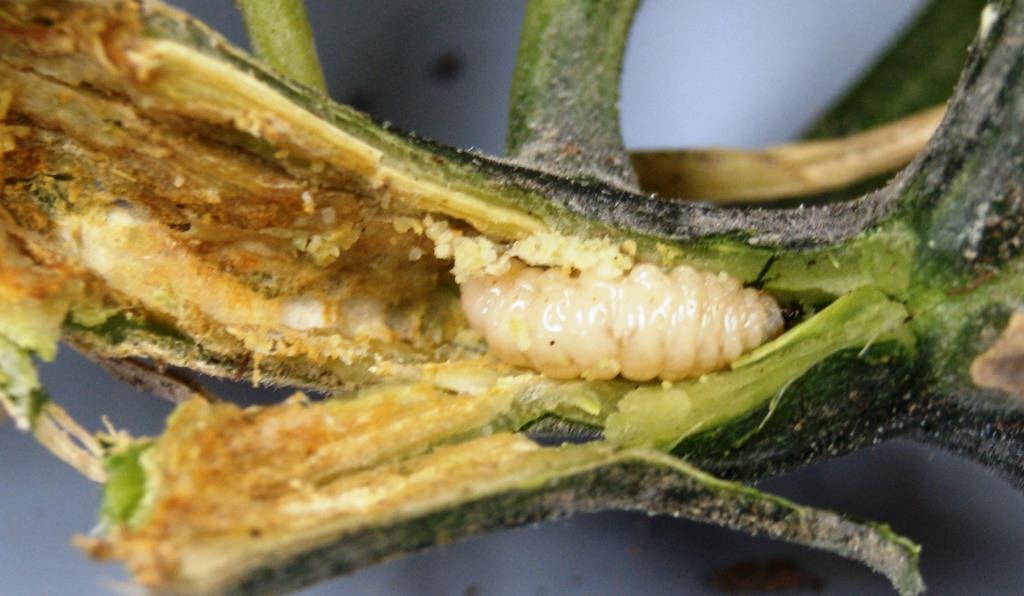
by Matthew Orwat | Jul 15, 2013
Why is my squash wilting? Assuming you have been giving your vegetable garden adequate water, the Squah Vine Borer may be the cause.
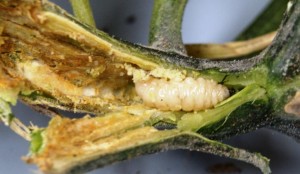
Squash Vine Borer larva. Image Credit Matthew Orwat
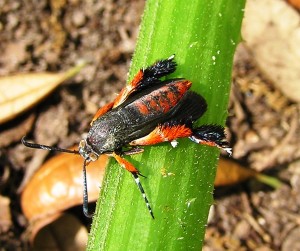
Adult Moth. Image Credit Theresa Friday
Unfortunately presence of the squash vine borer, the larval form of a clearwing moth, is usually noticed only after damage is permanent. Prevention is possible with early recognition through vigilant scouting.
The adult moth is common in gardens throughout Northwest Florida, and is easily recognizable due to its black and orange coloration.The 1/2 inch moth is active during the day and will lay a single tiny orange egg at the base of healthy squash plants.
It only takes a week for the egg to hatch and for the larva to bore into the stem. Once the larva in inside the stem, it chews its way up the stem, blocking the transport of water from the roots to the shoots. By the time wilting is noticed, total blockage of the water conducting tissue (Xylem) is likely.
If the moth is noticed in the garden, preventitive application of Bt (Bacillus thuringiensis) or pyrethroid (permethrin or bifenthrin) insecticide to the base of the stem may stop their incursion into the vine. Yellow traps full of water can be put out to monitor for them, since they are attracted to anything yellow.
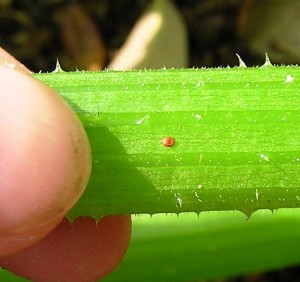
Squash Vine Borer Egg. Image Credit Theresa Friday
If the vine is already affected, insecticide applications will not help. There is a slim chance of saving it by cutting out the larva. While performing this task make sure to preserve the stem and bury the stem of the plant in a few inches of protective soil. The plant may grow new roots and resume production.
For more information about the Squash Vine Borer, proceed to this University of Kentucky article. To learn more about pests of Cucurbits, check out this informative UF / IFAS publication, Insects Management for Cucurbits.












